More coming soon….
Category Archives: Uncategorized
Pedalling Pioneers – SBS Exhibition
Sussex’s Cycling Stars & Suffragists
The advent of the bicycle in the late 19th century was a significant milestone in women’s history, particularly in Sussex. This revolutionary mode of transportation not only provided newfound mobility but also became a powerful symbol of women’s empowerment and liberation.
Despite societal concerns that lady cyclists would lose their feminine charms, resemble men, and neglect domestic responsibilities, the bicycle became a pivotal tool for social and political change.
From the late 19th to early 20th century, pioneering women in Sussex embraced the bicycle, defying societal norms and leaving an indelible mark on history. These women transformed themselves and society through their passion for cycling, paving the way for future generations of trailblazers.
This digital exhibition explores the historical impact of bicycles from the 1890s to 1928, highlighting the role of cycling in Brighton and Hove, Bexhill, Newhaven, and Worthing. It celebrates how pedal power propelled women toward greater social and political freedom, forever altering the landscape of British society.
Muriel Brassey (1872-1930)

Muriel Brassey, known as Lady De La Warr, was deeply connected to cycling from an early age. Daughter of Lady Annie Brassey and Sir Thomas Brassey, Muriel’s adventures aboard the steam yacht Sunbeam were well-documented in her mother’s books. In 1891, Muriel married Viscount Cantelupe, and the couple soon moved to Bexhill Manor House.
Image: Muriel Brassey with her daughter, Bexhill 1900 – Courtesy of Bexhill Museum
In 1896, Muriel joined the cycling craze: “In the summer of 1896, succumbing to the popular enthusiasm for cycling, she [Lady De La Warr] bought a ‘beautiful Simpson patent lever chain cycle’, on which the De La Warr arms and her ladyship’s initials appeared in gold on the main tubing, while a neat gold watch was ingeniously fitted to the plated handlebar. The machine, on its arrival at Bexhill railway station, attracted much admiration”. (Bartley).
Muriel’s embrace of cycling contributed significantly to its social acceptance and burgeoning popularity among women of the aristocratic class. She became a fashion icon for cycling and a symbol of the changing times.
Flora Merrifield (1859–1943)
Flora Merrifield was a prominent suffragist in Brighton who tirelessly campaigned for women’s voting rights. In 1913, she played a pivotal role in the Great Pilgrimage, leading women marching from Brighton to Hyde Park to demand suffrage.

In the image above, Flora is in front of the van wearing a dark cape, holding her bicycle, marked with X. The Great Pilgrimage of 1913 was a march in Britain by suffragists campaigning non-violently for women’s suffrage, organised by the National Union of Women’s Suffrage Societies (NUWSS).
“Pilgrims were urged to wear a uniform, a concept always close to Katherine Harley’s heart (the march’s instigator). It was suggested that pilgrims should wear white, grey, black, or navy blue coats and skirts or dresses. Blouses were either to match the skirt or to be white. Hats were to be simple, and only black, white, grey, or navy blue. For 3d, headquarters supplied a compulsory raffia badge, a cockle shell, the traditional symbol of pilgrimage, to be worn pinned to the hat. Also available were a red, white and green shoulder sash, a haversack, made of bright red waterproof cloth edged with green with white lettering spelling out the route travelled, and umbrellas in green or white, or red cotton covers to co-ordinate civilian umbrellas.” (Crawford, 1999)
About 100 pilgrims started from Brighton on Monday 22nd July 2013, joined by supporters from Worthing, Littlehampton & Seaford, then picking up more as they passed through towns, many on bicycles. At Burgess Hill they were joined by a contingent from Eastbourne, then on to Cuckfield where they spent the night & were joined by a mid-Sussex group.
Over the next few days they passed through Crawley, Reigate & Redhill, Purley, Croydon & Vauxhall & on Saturday arrived in Hyde Park, London. Flora helped lead campaigners on bicycles, demonstrating how cycling could be a powerful tool for social change and part of her commitment to women’s rights:
“Most women travelled on foot, though some rode horses or bicycles, and wealthy sympathisers lent cars, carriages, or pony traps for the luggage. The intention was not that each individual should cover the whole route but that the federations would do so collectively.” (Tickner, 1988).
These marches showcased bicycles as tools for social change, and the pilgrimage itself marked a significant moment in the suffrage movement, with 50,000 attendees rallying in Hyde Park. Flora’s efforts highlighted the intersection of cycling and political activism, demonstrating how bicycles could be instruments of liberation and social progress.
Mrs Hutton Moss

Mrs Hutton Moss was known for her elegant and intricate cycling performances in Brighton. Her husband owned a gymnasium in Hove, where she honed her skills. Mrs Hutton Moss’s performances caught the eye of high society, including royalty. Her exhibitions demonstrated the versatility and entertainment value of cycling, challenging traditional perceptions and elevating the status of female cyclists.
Image: Mrs Hutton Moss in Brighton Pavilion Gardens in The Cycle World Illustrated 1896. Credit The National Cycling Archive Warwick University.jpg
“On 10 April 1896 the Duke and Duchess of York, and Mr and Mrs Reuben Sassoon watched an exhibition of fancy cycle riding by ladies, which included Mrs Edward Sassoon and Mrs Hutton Moss. According to a report some exceedingly intricate and graceful figures were executed.” (The Cycle World Illustrated, 1986)
She captivated audiences in Brighton and beyond and shifted perceptions of cycling from mere leisure to a spectacle of skill and elegance, challenging traditional notions of femininity and entertainment.
Tessie Reynolds (1877-1954)

At just 16, Brighton based Tessie Reynolds made history with a record-breaking ride from Brighton to London and back in 1893.
Teresa “Tessie” Reynolds was born on 20th August 1877. She was the eldest of eleven siblings. By 1885 the family had moved to Kemptown, Brighton. The Reynolds were deeply connected to the cycling world. Tessie’s father Robert James Reynolds ran cycle and athletic depots on Brighton Road and Bristol Road. He was a member of the National Cycle Union, a race official, an athletics coach and secretary of a local cycle club. Tessie’s mother Charlotte (née Galton) managed the family’s boarding house, a popular cyclists’ haunt.
The Reynolds children learned to cycle, fence, box and play sports of all kinds under their father’s instruction. Preston Park Velodrome, Britain’s first purpose-built cycling track established in 1877, was three miles from the Reynolds’s home. The popular London to Brighton cycle route brought leisure riders and competitive cyclists right to their doorstep. This exposure to cycling gave Tessie the competitive edge she needed to become a world-class athlete.
Lady cyclists were rare when Tessie took to the road. The cycling craze of the mid to late Victorian era, when men and women took up cycling en masse as a leisure fashion, was still a few years away. Women’s racing occupied a space somewhere between sport and entertainment. There was a small, exciting and clandestine circuit of women’s high wheel and safety bicycle racing in the 1880s and 1890s.
For the most part, however, women’s cycle sport was frowned upon as unhealthy, immoral and contrary to notions of femininity. Tracks that allowed women to compete risked having their credentials revoked by cycle racing unions. The question of dress stoked the debate further. Conventional skirts and dresses were not compatible with cycling sport. Professional female racers opted for gymnastic style tights, men’s racing breeches or rational dress.
The first officially recorded women’s bicycle track race in Britain took place at the Recreation Grounds, Great Yarmouth on 7th August 1893. It was a one-mile handicap featuring four female competitors. Teen sensation Tessie Reynolds, riding for the Brighton Wanderers, came in first place. She won a china tea set.
One month later, on 10th September 1893, at 5am, a strange scene unfolded outside Brighton Aquarium. While the sun was still rising, a young girl in knickerbockers mounted a racing bicycle and set out for London. She was 8 hours and 38 minutes away from setting a new record for riding from Brighton to London and back again. Reynolds attracted attention not just for her racing prowess but for wearing rational dress. By publicly challenging gender conventions Tessie contributed to the wider struggle for women’s rights, freedoms and suffrage.
For her London-Brighton-London record attempt, Tessie rode a diamond-framed Premier safety bicycle geared for speed and kitted out for racing. It was a man’s bike, with a cross bar and drop handlebars, unlike women those ladies were expected to ride at the time. Tessie designed and, with her sister’s help, made her a rational cycling costume consisting of knee-length knickerbockers and a long jacket cinched at the waist. Black stockings, a white blouse, black riding shoes and a hat completed the ensemble. Bicycling News called the outfit “suitable and graceful.” (Bicycling News, 1893)
Three male pacemakers accompanied Tessie when she set out at 5am on the big day. She rode non-stop to Hyde Park, arriving at 9.15am. The return journey had three stoppages, Smitham Bottom, Crawley and Hickstead. At 1.38pm she crossed the finish line back at The Aquarium. Clocking in at 8 hours and 38 minutes for 120 miles, Tessie had set a new record. Her victory was bittersweet, however, since the official racing bodies refused to recognise a record set by a woman.
Tessie’s ride caused a press sensation. Most of the coverage was less than complimentary with some men calling Tessie’s record a “lamentable incident” and reacted with “pain, not unmixed with disgust.” Cycling magazine called her outfit “of a most unnecessarily masculine nature and scantiness.” (Hanlon, Record breaking Brighton cyclist, Tessie Reynolds, n.d.).
Leading cycle racer and commentator George Lacy Hillier leapt to Tessie’s defence. In the 30th September 1893 edition of Bicycling News, he praised her athleticism and choice of sensible dress. Hillier declared her “the stormy petrel heralding the storm of revolt against the petticoat.” (Hanlon, Tessie Reynolds: The Stormy Petrel in the Struggle for Women’s Equality in Cycle Racing and Dress, 2018)
In May 1894, Tessie Reynolds invited a group of enthusiastic cyclists to her residence, at 19 Bristol Road where they agreed to set up the Brighton and District Ladies’ Cyclist Club. A committee was appointed & an inaugural run to Bramber, starting from the Aquarium at half-past six, the following Wednesday was agreed.
Tessie’s record lasted for a year. In September 1894 Miss E Annie White of the Dover Road Club, Lewisham bettered it with a time of 7 hours, 56 minutes, 46 seconds.
Little is known of Tessie’s life beyond her peak as a cycle racer. The Brighton and District Ladies’ Cyclist Club continued over the next few years, with rides and dances, and was the only women’s cycling club in Sussex. Throughout her life Tessie continued to be a champion of rational dress and an outspoken proponent of women’s rights as cyclists and citizens.
Tessie Reynolds smashed not only a road record, but barriers limiting what women could do. Her 1893 ride from Brighton to London and back was an important landmark in women’s athletics, dress reform and suffrage. She is an unsung hero of British sporting history and a Brighton native to be proud of. (Hanlon, Tessie Reynolds: The Stormy Petrel in the Struggle for Women’s Equality in Cycle Racing and Dress, 2018)
Her feat challenged gender norms and showcased not only women’s cycling prowess but women’s physical capabilities. An advocate for rational dress, women’s rights and convenor of an all-women cycling club, she sparked debate and national media coverage. Her achievements underscore the evolving role of women in sports and society, making her a trailblazer in both cycling and women’s rights movements.
.

Rational Dress – SBS Exhibition
Cape & Courage
The advent of the bicycle in the late 19th century brought about a seismic shift in women’s lives and society at large. In Sussex, as in many other parts of the world, cycling became a pivotal force, providing women with newfound freedoms and a powerful platform for empowerment.
Despite societal fears that lady cyclists would lose their feminine charms, look like men, and leave their husbands to tend to the children, the bicycle catalysed a movement towards gender equality and social reform.
This online exhibition explores the historical impact of bicycles from the 1890s to 1928, highlighting the role of cycling in Brighton and Hove, Bexhill, Newhaven, and Worthing during an era when pedal power propelled women toward greater social and political change.
Cape and Courage
The struggle for women’s rights and societal acceptance often took the form of battles over attire. ‘Rationals’ were a controversial costume that defied Victorian conventions, which dictated that women wear long skirts or dresses with high collars, long sleeves, and up to seven pounds of whale-bone corsets. From the controversial knickerbocker trousers and bloomers to innovative convertible cycle wear, these garments became symbols of empowerment and liberation.
Unconventional Attire
Women who cycled in ‘rational dress’ challenged societal norms by defying restrictive clothing conventions. Rational dress typically included knickerbocker trousers, which revealed the legs and were widely criticised in the press for their moral outrage and shocking impropriety. It challenged Victorian norms, defying conventions of long skirts and corsets for women. Women who cycled in ‘rational dress’, including trousers (widely considered as underwear) were widely commented on for their lack of feminine charm.
These garments allowed women the physical freedom to cycle comfortably and safely, marking a significant departure from the cumbersome and hazardous attire traditionally worn by Victorian women.
Visibility and Criticism
Tessie Reynolds, a teenage cycling enthusiast from Sussex, became a national sensation due to her record-breaking Brighton-London-Brighton ride in a knickerbocker outfit she designed & made with her sister. In a letter to Bicycling News dated September 30, 1893, she wrote, “You have no doubt heard of my riding in knickerbockers. I should like to know your opinion on this costume for ladies. I find mine very comfortable and convenient.” (Hanlon, Tessie Reynolds: The Stormy Petrel in the Struggle for Women’s Equality in Cycle Racing and Dress, 2018).
Her attire was considered a ‘lamentable incident’ of ‘unnecessary masculine nature and scantiness,’ reflecting the period’s deeply ingrained gender norms and the backlash against women stepping outside traditional roles. More HERE
The advent of the bicycle in the late 19th century brought about a seismic shift in women’s lives and society at large. In Sussex, as in many other parts of the world, cycling became a pivotal force, providing women with newfound freedoms and a powerful platform for empowerment.
Despite societal fears that lady cyclists would lose their feminine charms, look like men, and leave their husbands to tend to the children, the bicycle catalysed a movement towards gender equality and social reform.
This online exhibition explores the historical impact of bicycles from the 1890s to 1928, highlighting the role of cycling in Brighton and Hove, Bexhill, Newhaven, and Worthing during an era when pedal power propelled women toward greater social and political change.
Cape and Courage
The struggle for women’s rights and societal acceptance often took the form of battles over attire. ‘Rationals’ were a controversial costume that defied Victorian conventions, which dictated that women wear long skirts or dresses with high collars, long sleeves, and up to seven pounds of whale-bone corsets. From the controversial knickerbocker trousers and bloomers to innovative convertible cycle wear, these garments became symbols of empowerment and liberation.
Unconventional Attire
Women who cycled in ‘rational dress’ challenged societal norms by defying restrictive clothing conventions. Rational dress typically included knickerbocker trousers, which revealed the legs and were widely criticised in the press for their moral outrage and shocking impropriety. It challenged Victorian norms, defying conventions of long skirts and corsets for women. Women who cycled in ‘rational dress’, including trousers (widely considered as underwear) were widely commented on for their lack of feminine charm.
These garments allowed women the physical freedom to cycle comfortably and safely, marking a significant departure from the cumbersome and hazardous attire traditionally worn by Victorian women.
Visibility and Criticism
Tessie Reynolds, a teenage cycling enthusiast from Sussex, became a national sensation due to her record-breaking Brighton-London-Brighton ride in a knickerbocker outfit she designed & made with her sister. In a letter to Bicycling News dated September 30, 1893, she wrote, “You have no doubt heard of my riding in knickerbockers. I should like to know your opinion on this costume for ladies. I find mine very comfortable and convenient.” (Hanlon, Tessie Reynolds: The Stormy Petrel in the Struggle for Women’s Equality in Cycle Racing and Dress, 2018).
Her attire was considered a ‘lamentable incident’ of ‘unnecessary masculine nature and scantiness,’ reflecting the period’s deeply ingrained gender norms and the backlash against women stepping outside traditional roles.
Innovation and Controversy
The debate over women’s cycling attire was not confined to the press but extended to technological innovations. In 1896, Charles Henry Hart of Eastbourne patented a safety cycling habit skirt designed to provide the mobility required for cycling while maintaining a semblance of traditional femininity.
Tessie Reynolds, reflecting on her designs, noted, “I have received many applications for patterns of my suit from ladies…I have not a pattern for it as I cut it out and made it entirely from my idea of what was wanted.” (Reynolds, 1893). This spirit of innovation and practicality drove the evolution of women’s cycling apparel, often amidst significant controversy (Jungnickel, 2018).
Mixed Reactions
Rational dress divided opinion within women’s cycling associations. Clubs were both supportive and critical of the attire, and women faced a mix of praise and censure. One woman recounted her experience of cycling through a town in rational dress: “An elderly lady imparted the information I was a ‘forward young minx!’ One man—how I thanked that man—doffed his oily cap and exclaimed, ‘Bravo! I likes yer pluck!’” (Manners, 2015). Such mixed reactions underscored the broader societal debates about women’s roles and freedoms during this period.
Scathing Editorials
Publications like Cycling: An Illustrated Weekly were harshly critical of rational dress. They denounced it as “unnecessarily masculine” and refused to name teenage cycling stars like Tessie Reynolds. One editorial noted, “We will not pander to the unwholesome vanity of the Brighton female scorcher by either advertising her name or the time she did it in.” (Fishpool, 2018). These scathing remarks highlight the resistance to women’s growing independence and visibility in public spaces.
The Legacy of Rational Dress
Rational dress, while controversial, proved far more suitable for cycling than traditional women’s clothing. The restrictive nature of skirts and corsets was incompatible with the physical demands of cycling, particularly for racing and time trials. Despite criticism, rational dress paved the way for greater freedom and mobility for women.
One female cyclist eloquently captured this sentiment: “To women, it has brought new life, wider, freer, and more delightful than was dreamt before its coming.” This shift in attire contributed to broader societal changes, ultimately aiding the movement towards women’s suffrage, achieved in 1928.
Cycling as a Gateway to Freedom
For many women in Sussex and beyond, cycling offered unprecedented opportunities to explore the countryside and escape the confines of their domestic lives. The bicycle became a symbol of independence and a tool for social change. Even those who cycled in skirts, which made the activity more arduous, benefitted from the newfound ability to journey into previously inaccessible areas. Cycling fostered a sense of adventure and liberation, allowing women to assert their presence in public spaces and participate in social and political movements.
In conclusion, the bicycle’s impact on women’s lives in Sussex from the 1890s to 1928 was profound. It challenged and transformed societal norms, providing women with a means of physical and symbolic liberation. This exhibition celebrates the brave women who pedalled their way towards greater freedom and equality, forever altering the landscape of gender roles and expectations. Through their stories and the evolution of cycling attire, we gain insight into a pivotal chapter in the history of women’s rights and social progress.
.
References
Fishpool, M. (2018, September 10). MILES AND LAPS: WOMEN’S CYCLE RACING IN GREAT BRITAIN AT THE TURN OF THE 19TH CENTURY – PART I. Retrieved from Playing Pasts: https://www.playingpasts.co.uk/articles/gender-and-sport/miles-and-laps-womens-cycle-racing-in-great-britain-at-the-turn-of-the-19th-century-part-i/
Friend, B. (2018, March 6th). The Role of the Bicycle in the Suffragette Movement. Retrieved from We Love Cycling: https://www.welovecycling.com/wide/2018/03/26/role-bicycle-suffragette-movement/
Hanlon, S. (2016, January 4th). Bicycle Face: A guide to Victorian cycling diseases. Retrieved from Women’s Cycling: http://www.sheilahanlon.com/?p=1990
Hanlon, S. (2018, May 27th). Tessie Reynolds: The Stormy Petrel in the Struggle for Women’s Equality in Cycle Racing and Dress. Retrieved from Women’s Cycling: http://www.sheilahanlon.com/?p=1830
Jungnickel, K. (2018). Bikes and Bloomers. Victorian Women Inventors and Their Extraordinary Cycle Wear . London: Goldsmiths Press.
Manners, W. (2015, February 15). ‘Womanly Cycling’- Part Two. Retrieved from THE VICTORIAN CYCLIST: https://thevictoriancyclist.wordpress.com/2015/02/15/womanly-cycling-part-two/comment-page-1/
Reynolds, T. (1893, September 30th). letter to Bicycling News. Retrieved from National Cycle Archive – University of Warwick: https://warwick.ac.uk/services/library/mrc/archives_online/digital/nca/
The Keep archive . (1925). Brighton Herald newspaper. Retrieved from The Keep archive: https://www.thekeep.info/collections/getrecord/GB179_NEW_33_1925
.

Historical & Project Context – SBS Exhibition
The advent of the bicycle in the late 19th century marked a profound transformation in women’s lives and society at large. In Sussex, as in many parts of the world, cycling became a pivotal activity, providing women with newfound freedoms and a platform for empowerment.
This digital exhibition explores the historical impact of bicycles from the 1890s to 1928, highlighting the role of cycling in Brighton and Hove, Bexhill, Newhaven, and Worthing during an era when pedal power was a force for women’s emancipation. Image: Lady Cyclist with Husband, Postcard, Whiting View Company, n.s., c. 1900 (Sheila Hanlon)

KP Projects CIC is a creative company that develops national and international outdoor art performances, installations & community engagment project, focused on sustainability, the environment and healthy living, with projects exploring cycling, recycling, and digital storytelling, amongst others. This exhibition sheds light on the historical impact of cycling in Sussex, showcasing how the bicycle was more than just a mode of transport; it was, and still is, a vehicle for social change.
Resistance and Challenges
The arrival of women cyclists was met with resistance from certain parts of society which felt threatened by the sight of women on bicycles. This opposition often manifested in verbal and physical abuse. ‘Some parts of society felt threatened by the sight of women cyclists…. & responded with verbal & sometimes physical abuse.’ (Jungnickel, 2018). Female cyclists also faced the creation of pseudo-medical ailments intended to discourage them from cycling.
Sheila Hanlon, a cycling historian, outlines these ailments, which included hysteria, inflamed fallopian tubes, the risk of foetal deformity, cyclist’s hump (kyphosis bicyclstarum), and the infamous Bicycle Face. These supposed ailments reflected societal anxieties about women stepping out of their traditional roles and gaining independence.



In 1897, male students protesting a vote to grant Cambridge University’s female students full degrees hung an effigy of a lady cyclist wearing ‘rational dress’ over the market square. This image had already become synonymous with the modern woman, symbolising resistance to change and modernity.
Impact and Empowerment
Despite these challenges, women eagerly embraced cycling. Owning a bicycle became a symbol of independence for 19th-century women. Through events, personal stories, and photographs, the bicycle is depicted in this exhibition as a symbol of freedom and progress for women in Sussex.
Women’s cycling clubs of the 1890s were more than mere leisure associations; they were spaces where women collectively worked to protect their rights as cyclists and citizens. The political interests of these clubs were evident in the topics chosen for evening lectures and club newsletters, which included dress reform, refugee rights, anti-vivisection, and suffrage. It was common for these clubs to support various causes through charitable drives, often benefiting needy members of their local communities. It was company and meant women could socialise unchaperoned.
Freedom and Leisure

Riding a bicycle offered women the freedom to explore the countryside, providing a respite from the confines of urban life. By the 1920s, cycling had become firmly established as a leisure activity. An advertisement in the summer of 1925 in the Brighton Herald urged readers to ‘Cycle your way to health and happiness,’ highlighting the health and recreational benefits of cycling (The Keep archive , 1925).
Women’s magazines of the time, such as Godey’s, celebrated the bicycle as a declaration of independence for women. As one article stated, “In possession of her bicycle, the daughter of the 19th century feels that the declaration of her independence has been proclaimed. (Friend, 2018)”. This sentiment captured the essence of the transformative power of the bicycle in women’s lives.
Cycling and Society
Mrs Hutton Moss, a notable figure in Brighton’s cycling history, exemplified the empowerment of women through cycling. Photographed on her 1896 Singer bicycle, Mrs Moss put on cycling displays and was a testament to the grace and skill of women cyclists.
On 20 February 1896, the Prince of Wales, Princess Louise, and the Duke of Fife attended one of her performances. Later, on 10 April 1896, the Duke and Duchess of York, along with Mr and Mrs Reuben Sassoon, watched an exhibition of fancy cycle riding by ladies, which included Mrs Edward Sassoon and Mrs Hutton Moss. These exhibitions showcased intricate and graceful figures, highlighting the artistry and athleticism of female cyclists. Image: Mrs Hutton Moss in Brighton Pavilion Gardens in The Cycle World Illustrated 1896. Credit: The National Cycling Archive, Warwick University

So, it wasn’t all bad news for lady cyclists during the cycling craze. Many doctors reassured their patients that the pastime could be taken up without concern if practiced in moderation. Prospective lady cyclists were encouraged to consult their physician to verify that they were fit and free of any underlying conditions that might be aggravated by cycling.
Medical professionals in favour of women’s cycling considered it harmless so long as overexertion, long rides, speed and accidents were avoided. Dr WH Fenton, a Harley Street physician, estimated that 90% of diseases afflicting Victorian women were “functional ailments, begotten of ennui and lack of opportunity of some means of working off their superfluous, muscular, nervous, and organic energy.” (Nineteenth Century, May 1896). Much later in the craze, cycling was championed as a healthy escape from the pressures of urban life and polluted factory air for working women (Hanlon, 2016).
Conclusion
The exhibition aims to provide a comprehensive look at the role of the bicycle in women’s lives in Sussex from the 1890s to 1928. It underscores the significance of cycling as a catalyst for social and political change, offering women independence, freedom, and a platform for empowerment.
Through a blend of historical narratives, personal stories, and visual displays, visitors online and in-person are invited to explore how the bicycle revolutionised women’s lives and contributed to the broader movement for women’s rights and social progress.
Nothing could stop the tide of change that the bicycle brought about. As women took to their bicycles, they not only embraced a new mode of transport but also heralded a new era of independence and empowerment.
This Sussex Blazing Saddles exhibition celebrates their journey and the enduring legacy of their resilience and determination in the face of societal challenges, and how this took place across Sussex.
References
Friend, B. (2018, March 6th). The Role of the Bicycle in the Suffragette Movement. Retrieved from We Love Cycling: https://www.welovecycling.com/wide/2018/03/26/role-bicycle-suffragette-movement/
Hanlon, S. (2016, January 4th). Bicycle Face: A guide to Victorian cycling diseases. Retrieved from Women’s Cycling: http://www.sheilahanlon.com/?p=1990
Jungnickel, K. (2018). Bikes and Bloomers. Victorian Women Inventors and Their Extraordinary Cycle Wear . London: Goldsmiths Press.
Middleton, J. (2020). Holland Road, Hove. Retrieved from Hove in the Past: https://hovehistory.blogspot.com/2020/03/holland-road-hove.html
The Keep archive . (1925). Brighton Herald newspaper. Retrieved from The Keep archive: https://www.thekeep.info/collections/getrecord/GB179_NEW_33_1925
.

Bexhill Sussex Blazing Saddles
Free Events & Activities 1-16 June
Come and enjoy FREE activities and events in Bexhill, uncovering the revolutionary history of women and cycling in Sussex. This two-week-long programme in Bexhill includes a variety of events and activities including upcycling sewing workshops to remake cycling fashion, talks, cycle repair sessions and free outdoor tours. Come and join in!
Bike Safety check for women & girls: To launch SBS events on Saturday 1st June, and Sunday 2nd June 12- 3pm there are Bike Safety Checks by Bexhill Wheelers, located just behind Bexhill Museum next to Egerton Park. We encourage women and girls to bring bicycles to ensure you can enjoy Bike Week.
Re-Imagining Re-Making women’s clothing for cycling, or any time, sewing workshops. Book a session or stay as long as you like: Saturday 1st June – 10.30-12.30 & 13.00-15.00 and Monday 10th June – 10.30-12.30 & 13.00-15.00 at the Eco Hub, Western Road, with Community Supporters. Come and transform preloved clothes—repair or make them fit; transform them completely by adding splashes of colour or different fabrics; or help us create a dressing-up box of upcycled bloomers and sashes for the Sussex Blazing Saddles exhibition.
Talks at Bexhill Museum
1: Friday 14 June 2.30pm With Julian Porter – Curator of Bexhill Museum, exploring memories of Bexhill and cycling of Bexhill cycle track, Pleasant Sunday Afternoon cycle club, Lady Brassey cycling passion, and
2: Sunday 16 June 2pm With Karen Poley – Sussex Blazing Saddles Creative Director introducing the project and its findings…
Pleasant Sunday Afternoon on Sussex Day Inspired by the PSA’s cycling club of the early 1900s, come and join us for a pleasant Sunday afternoon on Sunday 16 June. Meet at Bexhill Museum at 1.45pm, to look around the Exhibition and hear an introductory talk. Then cycle off on a Bexhill Women and Cycling heritage ride led by Ian Hollidge of Bexhill Wheelers. The route will last about an hour, encompassing the cycle chalet built by Muriel Brassey, the old cycle track and back for a musical finish with The Other Band, at the Coronation Bandstand. If you wish to stay on, the ride will cycle back to Egerton Park for a picnic at 7.30pm
.
Bexhill Schedule
1 June – Re-Imagining & Re-Making sewing sessions at the Eco Hub, Western Road, Bexhill 10.30-12.30 & 13.00-15.00
1 & 2 June – Women & Girls Bike Safety Checks by Bexhill Wheelers, Egerton Park back of Bexhill Museum 12-3pm
10 June – Re-Imagine Re-Make sessions at the Eco Hub, Western Road, Bexhill 10.30-12.30 & 13.00-15.00
14 June – Talk by Senior Curator Julian Porter Bexhill, Bicycles & Brasseys, Bexhill Museum 2.30pm
15 & 16 June, Bexhill Museum SBS Exhibition – themes from clothing to rides, races & events; Ladies cycling superstars, clubs & cycling suffragists; as well as current cycling clubs, promoting learning to ride & maintenance sessions for women.
16 June, Bexhill Pleasant Sunday Afternoon – exhibition, talk, heritage ride, & music – bring your bike & meet at Bexhill Museum at 1.45pm. The ride will last approximately an hour, finishing at the Coronation bandstand.
16 June, Bexhill talk by Creative Director Karen Poley Sussex Blazing Saddles, 2pm
,
A full list of all the Sussex Blazing Saddles (SBS) events taking place across Sussex in 2024 can be found HERE
.

Costume Archive Visit
On 2 May 2024, Sussex Blazing Saddles hosted a visit to Worthing Museum & Art Gallery’s Costume Archive. Seniour Curator, Gerry Connolly showed us a series of amazing utfits from the late 1800s to early 1900s, giving us an overview of womens’ clothing of our period (1890-1928).
From the tortuous constraints of Edwardian fashion & the incredible engineering of undergarments, to convertible horse riding outfits, in a similar vein to the convertible cyclewear featured in the Blazing Saddles show.
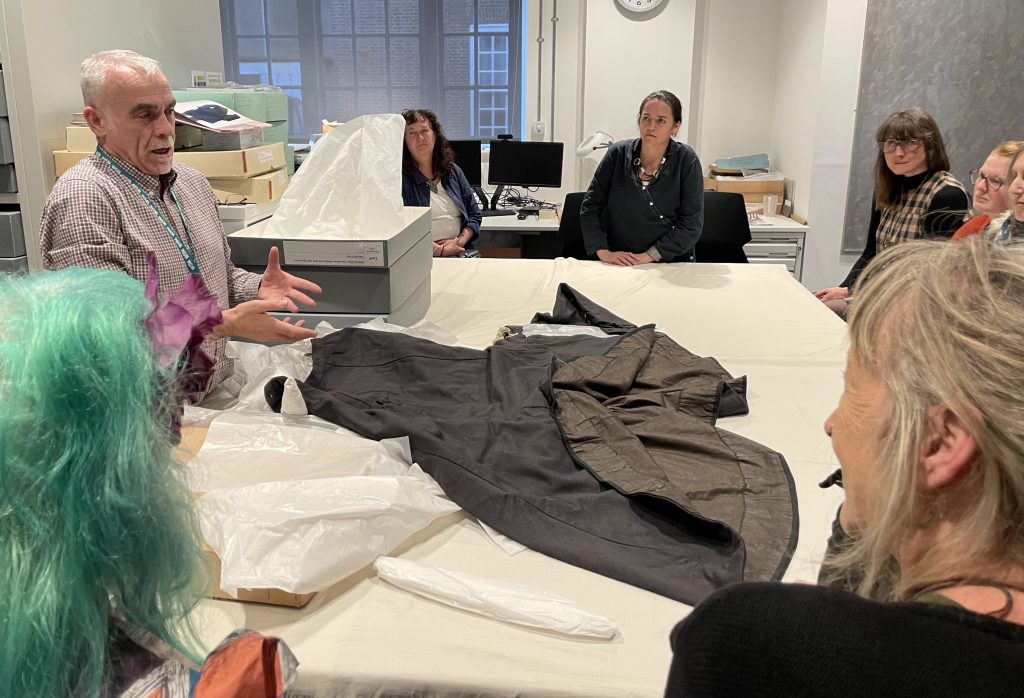









Huge thanks to Gerry & Worthing Museum & Art Gallery, & to everyone who came along from across Sussex for a fascinating introduction to costume archives & women’s clothing.
.

SBS Pop Up Exhibition
Following two years of research in local archives around Sussex, SBS created a pop up, touring exhibition which travelled to partner locations in June & September 2024, where it was seen by an estimated 38,300 visitors.
The exhibition was presented as a series of themes which emerged during research – from clothing to rides, races & events; pioneering lady bicyclists, clubs & cycling suffragists; as well as current cycling clubs, promoting learning to ride & maintenance sessions for women. You can explore the exhibition at this link
Photos © Raysto Images / KP Projects CIC 2024
.
Bexhill Museum 10-16 June, linking with Bike Week





.
Worthing Museum 18-30 June, as part of Worthing Festival





.
Newhaven Library 1-15 September, as part of Heritage Open Days and Newhaven Festival





.
Jubilee Library Brighton 16-29 September, coinciding with International Car Free Day & Kidical Mass
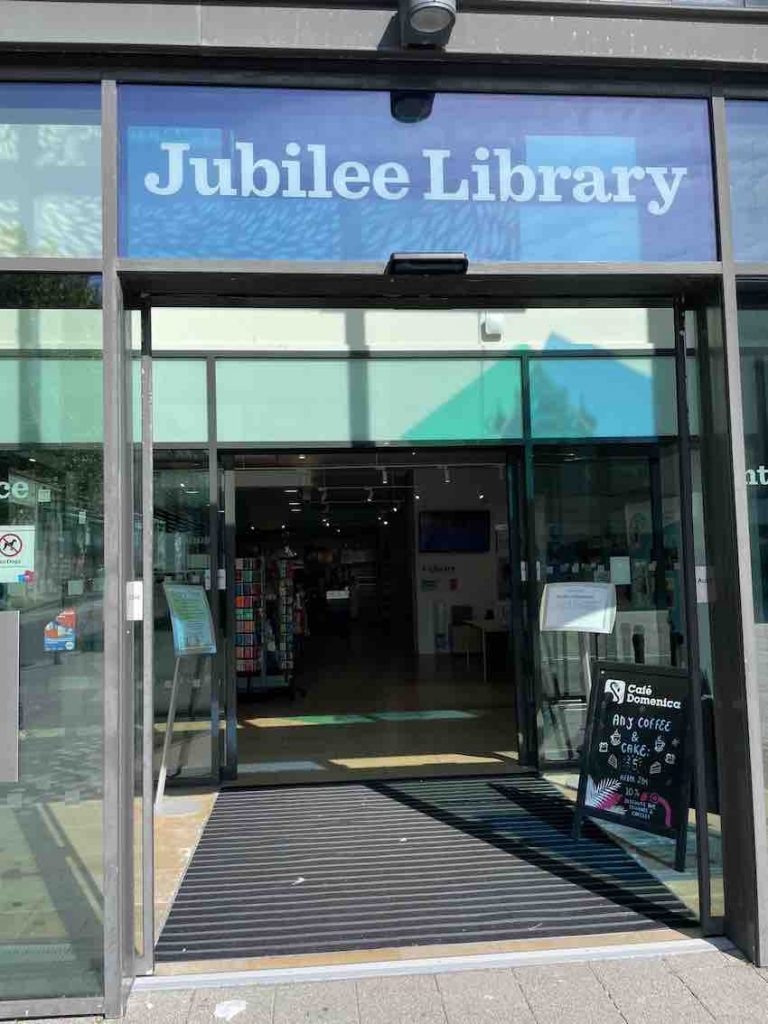



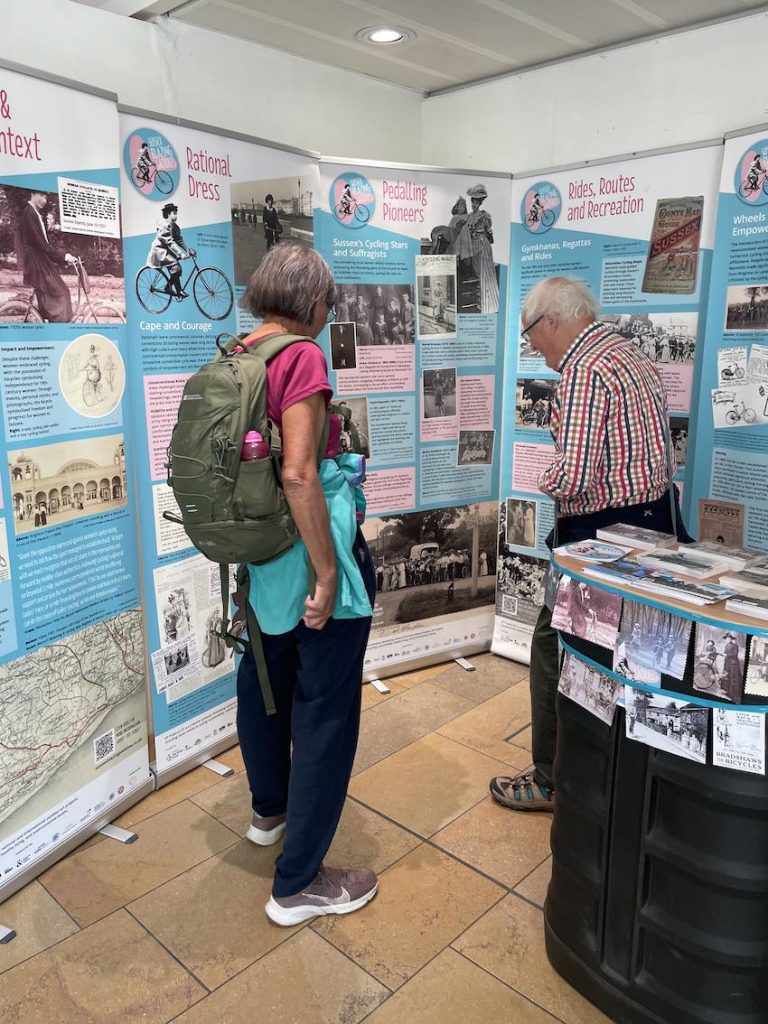

Photos © Raysto Images / KP Projects CIC 2024
Huge thanks for all the wonderful volunteer archive researchers who delved into the archives & dug out stories, & special thanks to Heritage Consultant Nicola Benge who led the volunteers & developed the exhibition with KP Projects.
.
.

Come & Dance with your Bicycle
FREE – SBS Taster Workshops in Newhaven & Brighton
We’re delighted to offer a series of fun, sociable taster sessions for you to learn some basic moves with your bike, develop your own moves & short sequences & work with the whole group to create a short choreography.
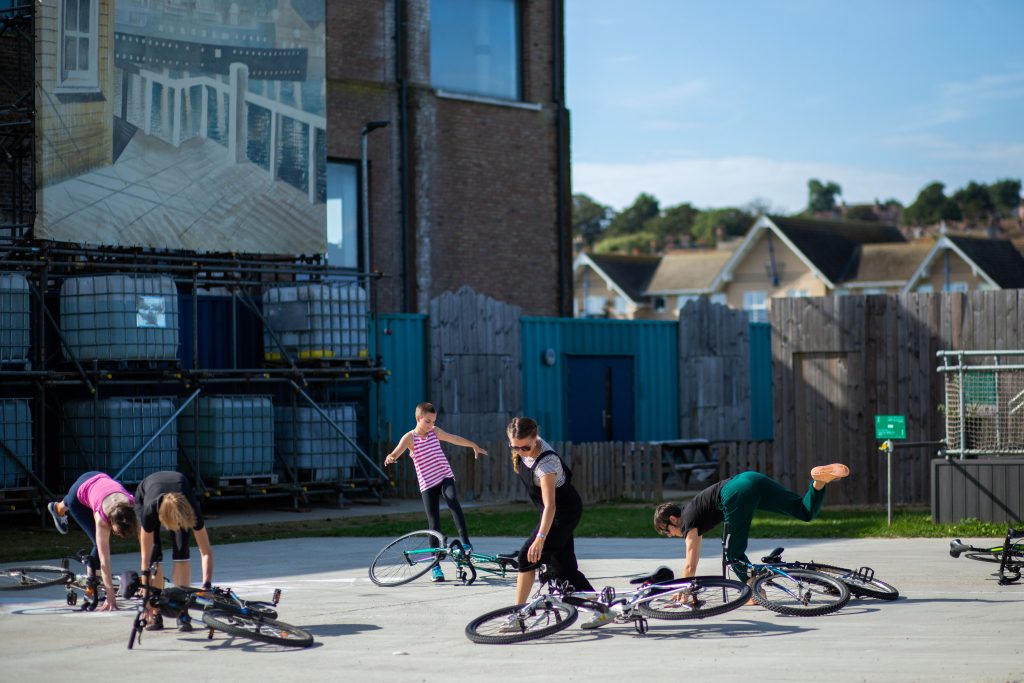
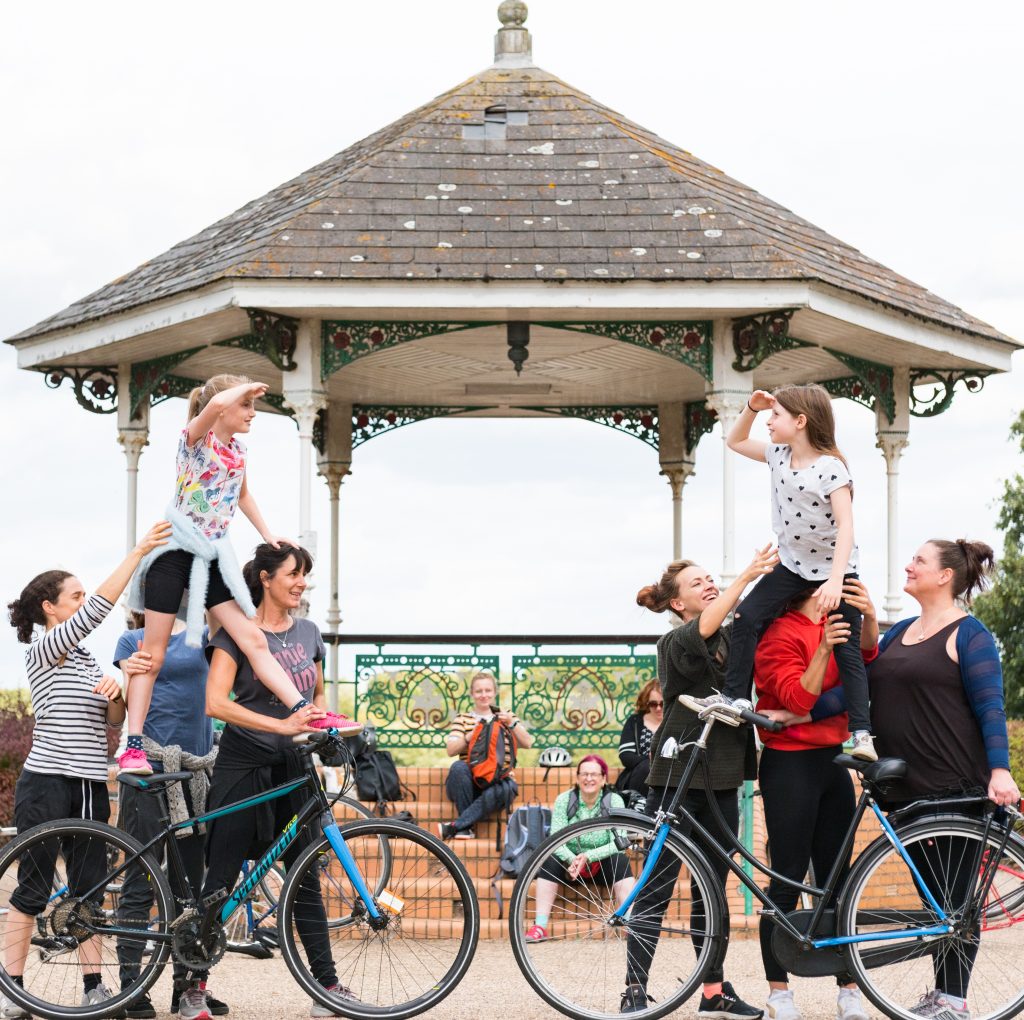
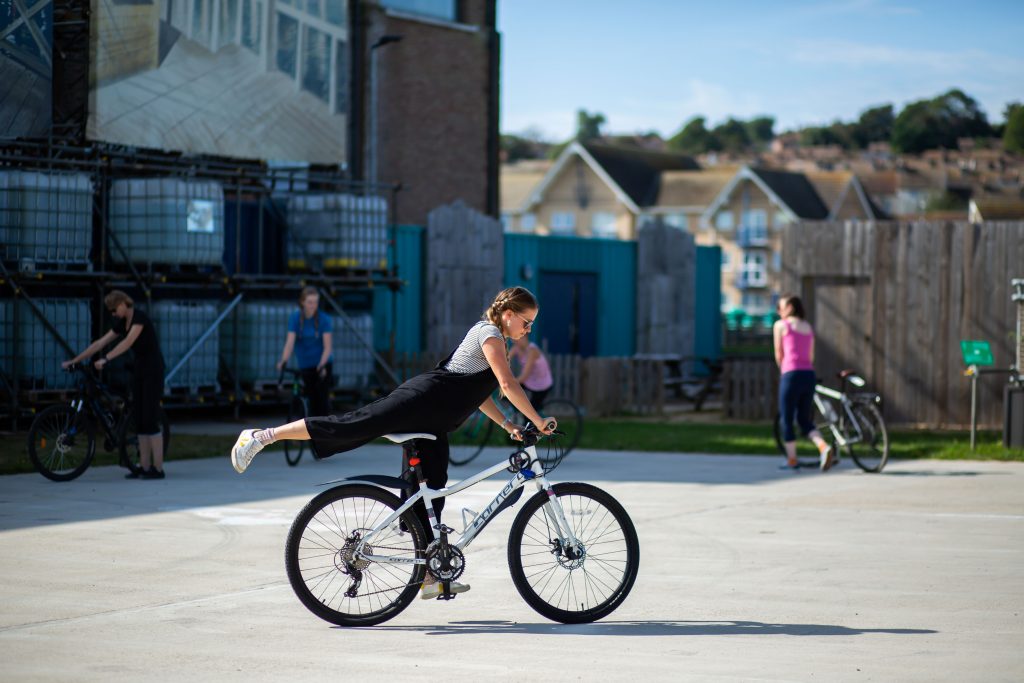
Confirmed dates so far:
22 June – 10.30am -12.30pm, Preston Park, Brighton
23 June – 10.30am-12.30pm, The Sidings, Newhaven
25 June – 5.45pm-7.45pm Haven Young Creatives, Newhaven
6 July – 10am-12noon with Our City Dances, Brighton
14 August – 6pm-8pm, Preston Park Brighton
30 August – 10.30-12.30pm, Third Space Theatre Summer School, Brighton
What you need to know: All ages are welcome, we just ask that you have a level of cycling proficiency, recommended Bikeability Level 2 – essentially that you can ride safely with one hand off the handlebar. Wear comfortable clothing & bring your bike.
Borrow a bike: some bicycles are available to borrow. If you need one, please contact us on info(at)sussexblazingsaddles.co.uk giving your age & height
Participate in the Show: If you love it, as we’re sure you will, please sign up to participate in Blazing Saddles shows in September. More info HERE
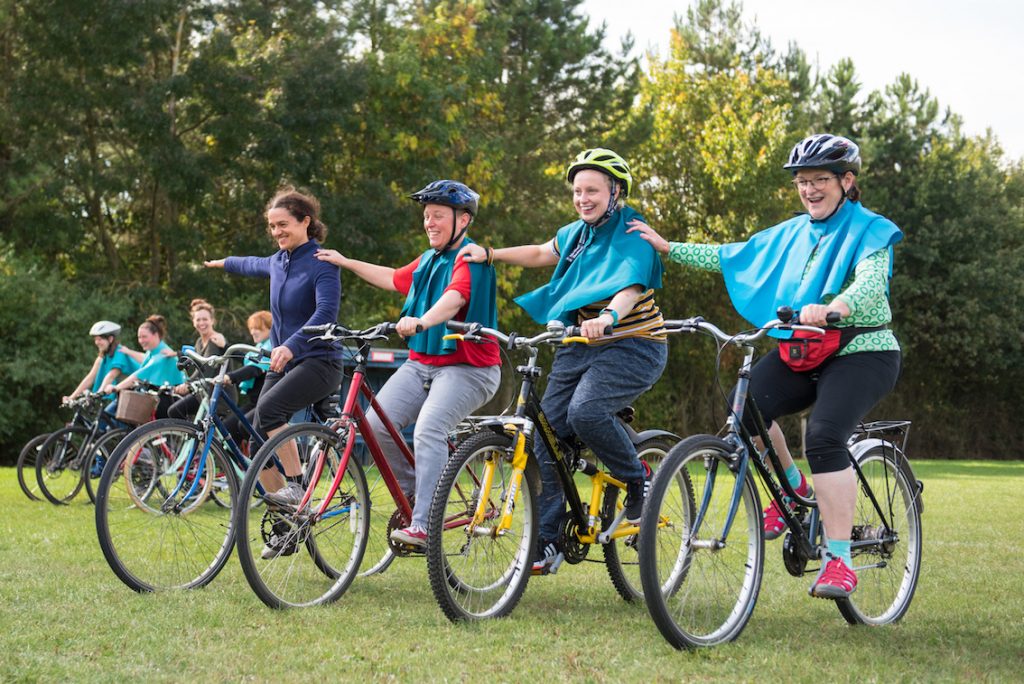
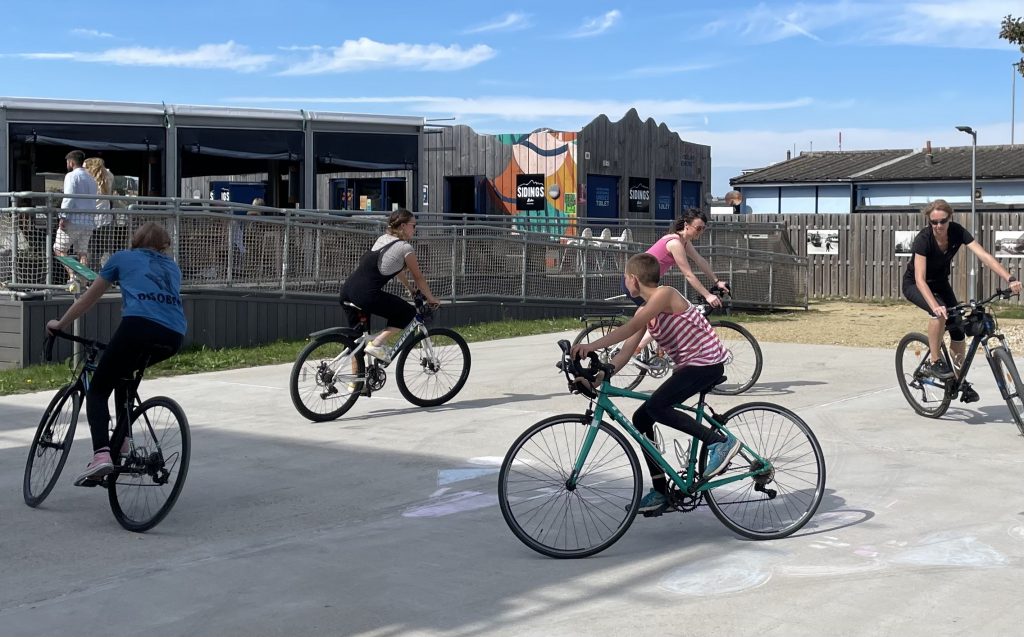
.

Come & Perform
Come & take part in a Sussex Blazing Saddles performance. The show is based on the moment women in the 1890s, transformed their clothing & society to be able to ride bicycles.
- to join the Newhaven show on 7 & 8 Sept, sign up HERE
- to join the Brighton show on 21 & 22 Sept, join HERE
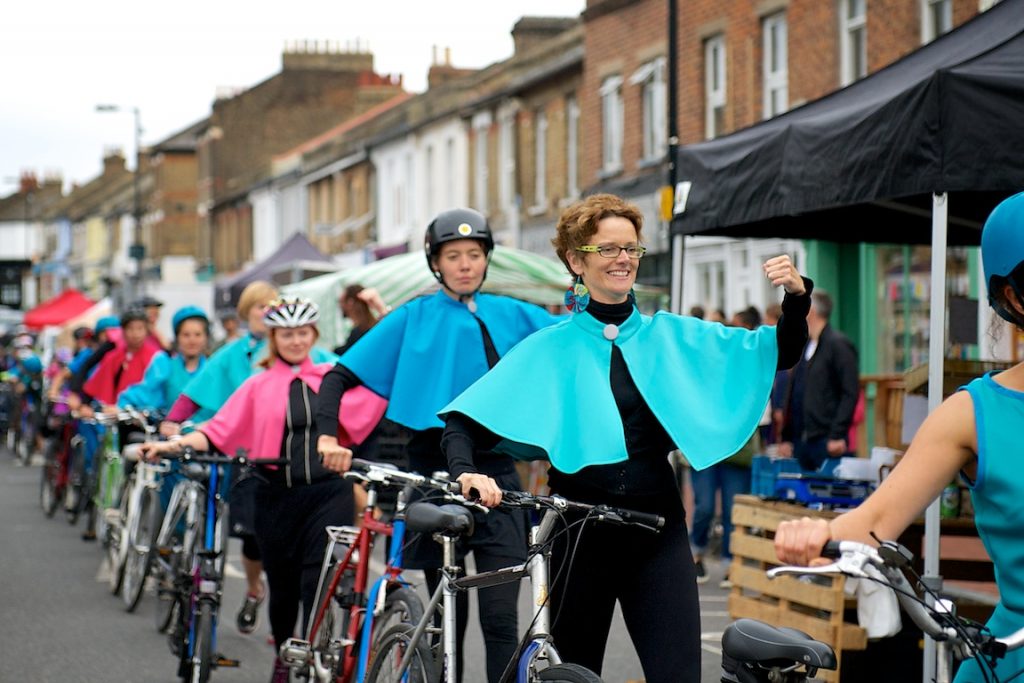
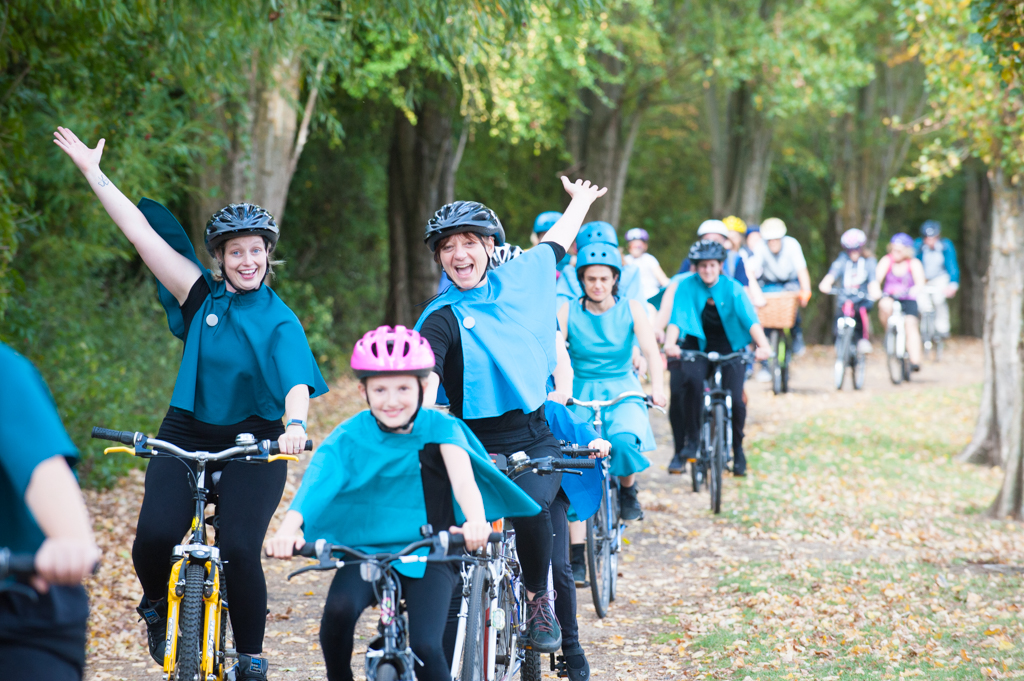
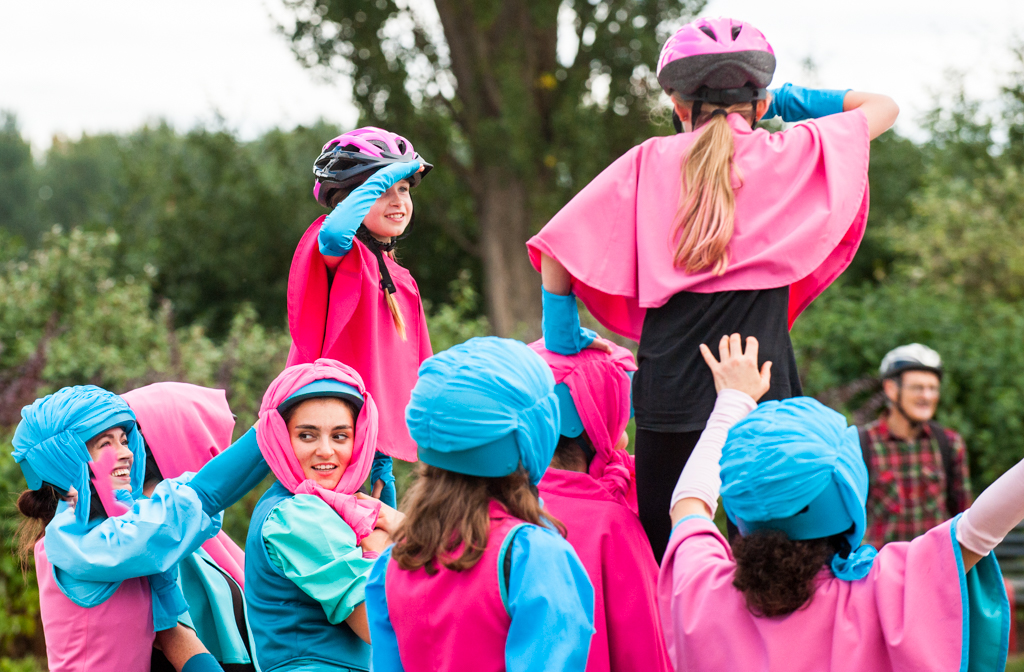
We will create the shows with local women & girls (you & your bike) over a weekend, starting with workshop/rehearsals & a ride around the performance sites on the first day; further rehearsal & performance on the second day.
You will learn the show’s choreographic structures & moves, as well as create your own moves & short sequences & work together safely as part of the cast. You will develop your cycling skills & confidence, improve control of your bicycle on the roads & as part of a group, & have the best fun doing so.
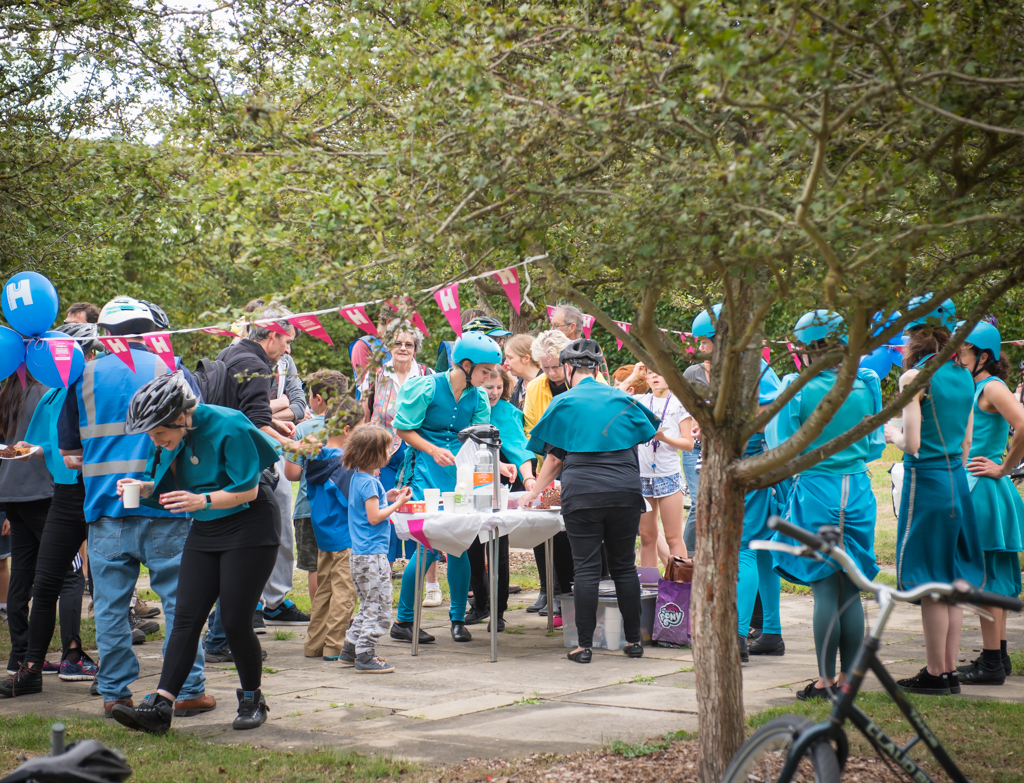
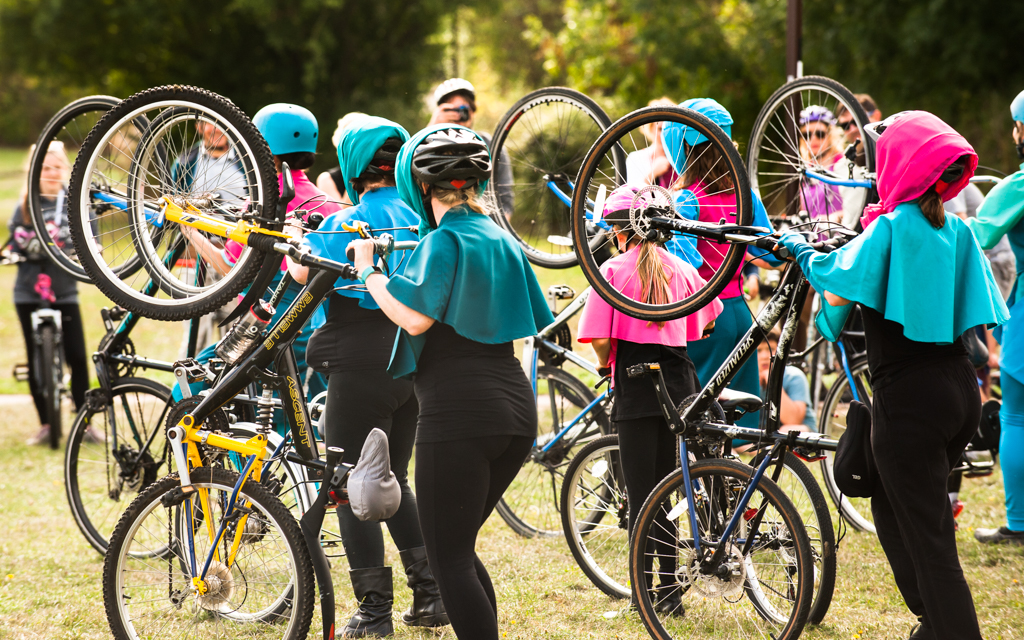
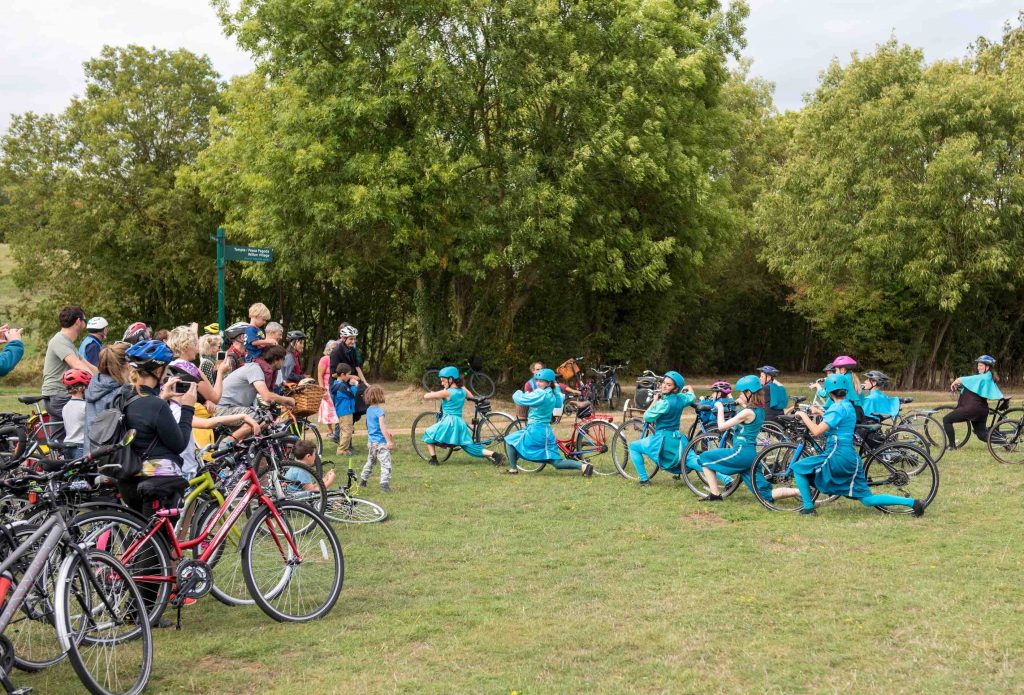
Previous Participants said…
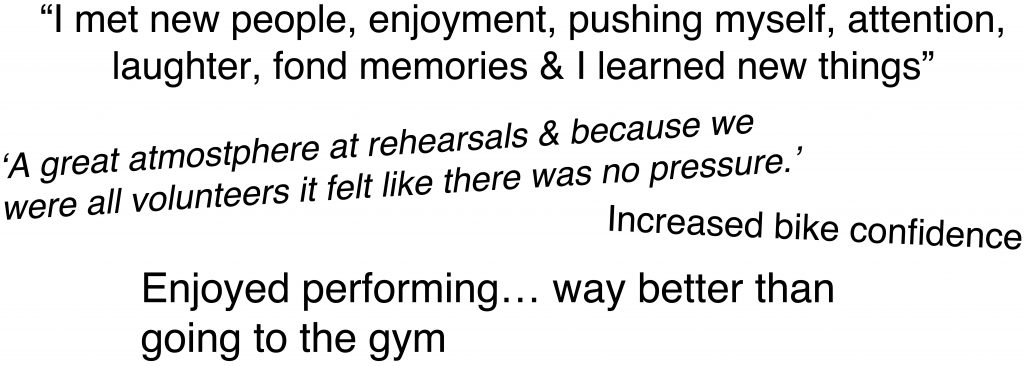
All ages welcome. Previous participants have been 8 to 80 years old; in their own words HERE

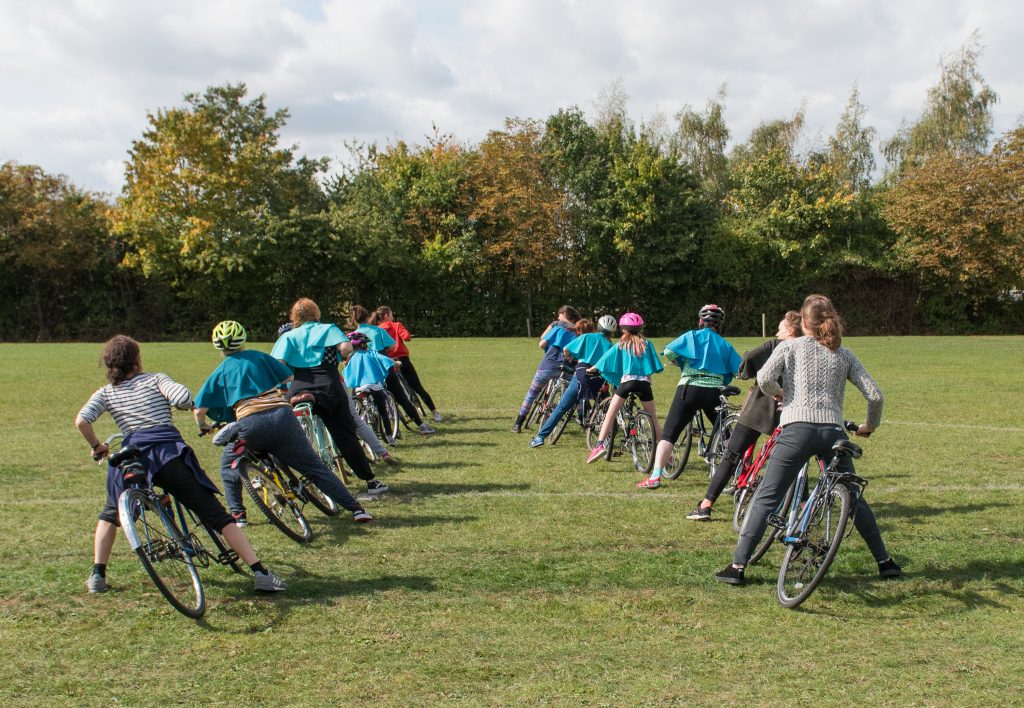
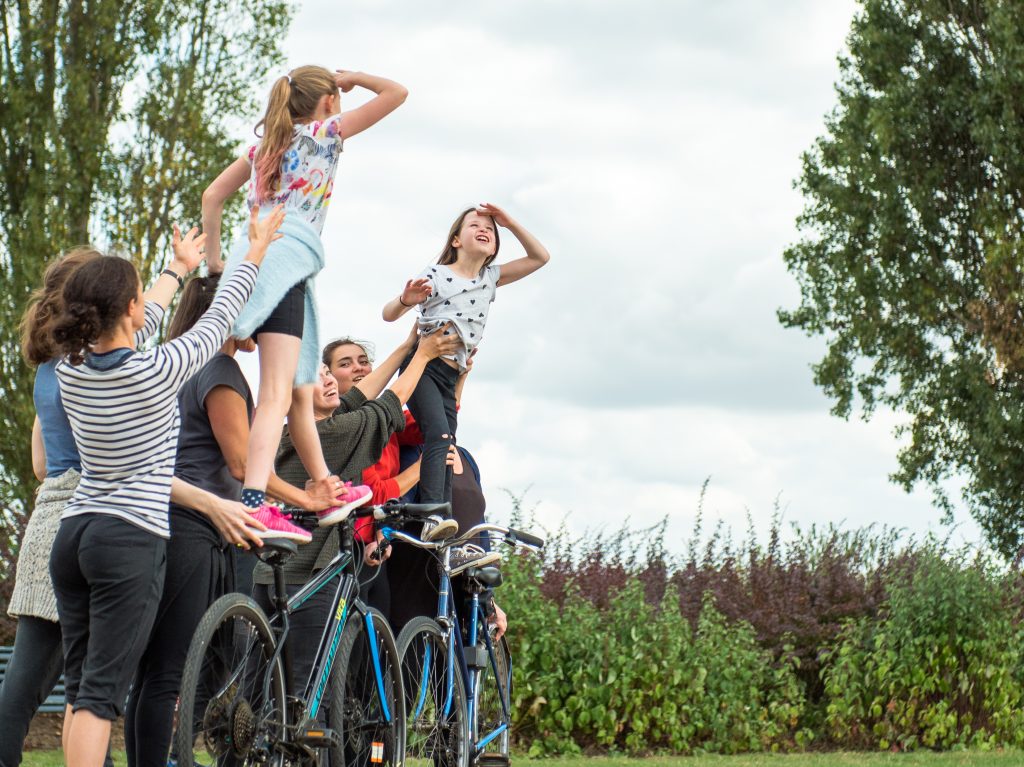
No experience necessary, apart from a basic level of cycling proficiency. Bikeability Level 2 is recommended – the equivalent of riding safely with one hand off the handlebar.
.
You can take part in either the Newhaven or Brighton shows, or both if you have the time/energy. Rehearsals & performance will take a whole weekend.
Here’s a very rough, draft schedule for both weekends:
Saturdays 7 Sept in Newhaven or 21 Sept in Brighton
9.30am-10am – Arrival
10am-1pm – Introductions, workshop to learn core skills & basic choreographic moves & introduction to the show choreography
1-2pm – Lunch break
2-4pm – Rehearse in performance site
…
Sundays 8 Sept in Newhaven or 21 Sept in Brighton
9.30am-10am – Arrival
10am-12.30pm – Rehearsal running through choreography
12-1.30pm – Lunch break
1.30-2.10pm – Costume call & prep
Leave 10 mins before show starts
2.30 & 4.30pm – Performances
There’s more information at the Eventbrite links. Sign up to join in above
….
Here’s a short film of the show
.

SBS Events Diary 2024
Loads of FREE activities & events throughout the year. The calendar below lists confirmed events only & we’re working on dates for a programme of FREE workshops to upcycle cycling outfits, dance with your bike & SBS heritage inspired rides. Follow us on Facebook & Instagram for updates
April
13 April, 11am-4pm, A FREE, all day or drop in sewing & remaking workshop at CREW 8-9 South Street, BN11 3AL. Participants made bloomers & sashes from men’s shirts for a dressing up box for the SBS exhibition. More HERE
May
2 May, Worthing Museum Costume Archive Training, an invited group visited the costume archive for a special talk, with examples from the collection, about 1890s-1928 women’s clothing constraints, contraptions & convertible horse riding outfits by Senior Curator Gerry Connolly
22 May, Newhaven, Come along & help us shape the Re-Imagining, Re-Making programme in Newhaven over the next few months. Hillcrest Centre Newhaven 6pm-8pm
June
1 June, Bexhill – Re-Imagine Re-Make session at the Eco Hub, Western Road, Bexhill time tbc
1 & 2 June, Bexhill – Women & Girls Bike Safety Checks by Bexhill Wheelers, Egerton Park back of Bexhill Museum 12-4pm
10 June – Bexhill, Re-Imagine Re-Make session at the Eco Hub, Western Road, Bexhill time tbc
14 June – Bexhill, talk by Senior Curator Julian Porter Bexhill Bicycles & Brasseys Bexhill Museum 2.30pm
15-16 June, Bexhill SBS Exhibition Bexhill Museum
16 June, Bexhill Pleasant Sunday Afternoon – heritage ride, talk & music – bring your bike & meet at Bexhill Museum at 1.30pm
16 June, Bexhill talk by Creative Director Karen Poley Sussex Blazing Saddles, 2pm
18 June – 9 July, Worthing SBS Exhibition Worthing Museum
22 June, Brighton Blazing Saddles Taster Workshop, Preston Park, 10.30am – 12.30pm
23 June, Newhaven Blazing Saddles Taster Workshop, The Sidings 10.30-12.30
25 June, Newhaven Blazing Saddles Taster Workshop with Young Havens Creatives
July
6 July, Brighton Blazing Saddles Taster Workshop with Our City Dances, Richmond Square 10-12noon, FREE but ticketed
10 July, Brighton SBS Creative Director Karen Poley’s talk for Better Bike Social
13 July, Brighton, re-imagining cycle clips & re-making preloved leggings at Sew Fabulous at the Old Market
31 July, Brighton, SBS Creative Director Karen Poley’s Pecha Kucha for Brighton & Hove Museum, tickets CANCELLED
August
14 August, Brighton Blazing Saddles Taster Workshop with choreographer Virginia Farman, 6pm – 8pm
30 August, Brighton Blazing Saddles Taster Workshop with Third Space Theatre’s Summer School
31 August, Newhaven, Drop-in sewing & upcycling workshop. Come along & re-imagine cycle clips & re-make session pre-loved leggins. Drop in to Hillcrest Centre 12.30-16.30 More info here
September
1-15 Sept, Newhaven SBS Exhibition, Newhaven Library, as part of Newhaven Festival
3 Sept, 7pm for 7.30pm start – SBS Talk with Newhaven Historical Society, Hillcrest Centre, Newhaven
7 & 8 Sept, Newhaven Participants workshops & rehearsal for Blazing Saddles performance 10am-5pm both days, more info
8 Sept, Newhaven Blazing Saddles Performance & Ride, 2.30pm-4.30pm, starting point Newhaven Skatepark & Pumptrack BN9 9DL
14 Sept, 11am, SBS Talk with Jubilee Library Brighton. Free but ticketed here
16-30 Sept, Brighton SBS Exhibition, Jubilee Library Brighton
21 & 22 Sept, Brighton Participants workshops & rehearsal for Blazing Saddles performance 10am-5pm both days, more info
22 Sept, Brighton Blazing Saddles Performance & Ride, 2.30pm-4.30pm, starting point St Peter’s Square Brighton BN1 4GU
.



